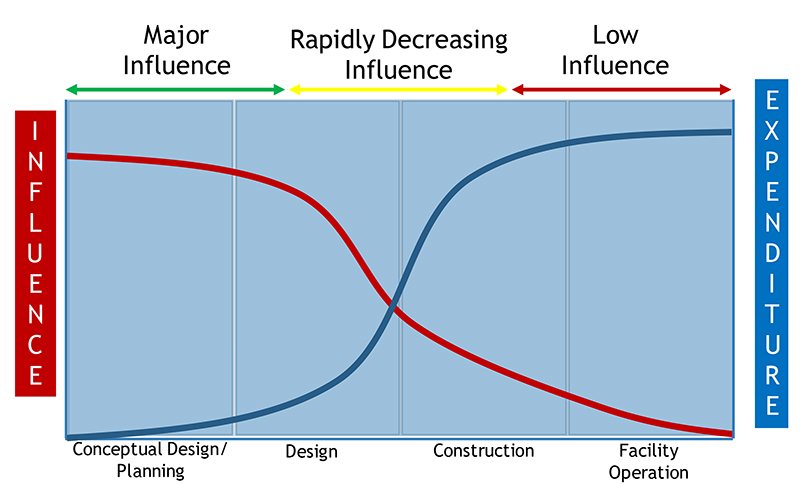Planning
An asset’s life cycle should begin here. It is highly likely that at this stage, the asset is part of a collective of assets that are being planned for, rather than a single asset, but this is not always the case. A single asset will be discussed here, with the understanding that assets are generally planned collectively. The same principles apply in either case.
Planning demands thoughtful and detailed analysis of current and future needs and a thorough evaluation of what the organization requires from the asset, and for how long.
During the planning phase, information about the asset should be collected that will help make decisions going forward. This information might include:
- Historical information – what has worked well in the past and what has not
- The environment in which the asset will reside
- The Level of Service the asset must provide
- Any benefits the asset provides, including a thorough consideration of co-benefits
- An informed projection of the funding required to bring the asset on board
- How much it might cost to operate and maintain the asset throughout its life cycle
- Any specialized training that might be required to operate and maintain the asset, including higher level operator certification
- How the asset can be abandoned in place, recycled, or disposed at the end of life
- How the asset will impact the Triple Bottom Line (financial, social, and environmental) of the system
The planning phase should bring many different staff from a wide variety of departments into the discussion. It is important to include operations personnel in the review of the asset during the planning, design, and construction phases, because they will be in charge of operating and maintaining the asset once it is installed. Involving these individuals early allows them to point out potential problems or suggest alternatives before much money has been invested. Seeking a variety of input strengthens the sense of team investment while increasing the range of factors for management to consider.
In many ways, the planning stage of an asset’s life cycle management is the most important. This is the part of the process where you have the most influence over the asset at the least cost. At this stage, the asset is only on paper, and it is easy to make a change to the asset. It is much harder to change an asset once it is installed. The graph below shows the influence (or ability to make a change to the asset) and the cost associated with the change in each phase.

Adapted from: Gibson and Hamilton (1994) Analysis of pre-project planning effort and success variables for capital facility projects. Construction Industry Institute Source Document 105.
The chart shows cost and influence curves as the project moves through its life cycle phases. The cost is initially low and increases as the project moves to operation. At this point, most of the costs are already sunk. The influence curve moves in the opposite direction from extremely high at the planning phase to extremely low at the operational phase. The lines cross during the design phase. This reality is why it is vitally important to consider planning the beginning of the asset’s life rather than when the asset is turned over after construction.
During the planning phase, evaluate a wide variety of alternatives that might be capable of achieving or maintaining the desired level of service and compare the full life cycle costs of each. A triple bottom line assessment should be completed to ensure the benefits of the asset are fully considered and optimized.
For example, two alternatives might each be able to provide the desired level of service, but one of them might be able to provide additional benefits over the other. In this case, the alternative with the additional benefits might be better for the organization. This situation can be particularly true for green assets, which might achieve the desired result while providing additional benefits for the community. Evaluating these additional benefits and how they impact the triple bottom line and the overall goals of the organization can impact the decisions made. Some of the benefits include recreation, urban heat mitigation, air quality improvements, flooding risk reductions, improved water quality, absorption of local carbon emissions, increased property values, or improved quality of life.
If the desired alternative is one that is relatively new to the water, wastewater, or stormwater industry, the system might want to consider implementing a pilot project. A pilot project can establish the asset’s ability to achieve the desired result or serve as proof of concept when seeking approval or funding.
During the planning phase, the system might need to be able to market its project to obtain funding. Further discussion on this topic can be found here.